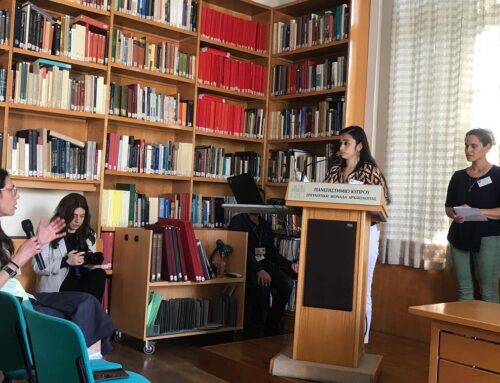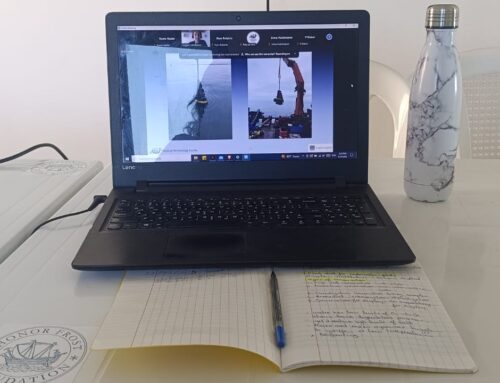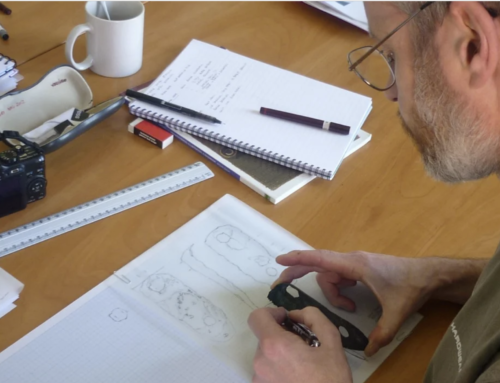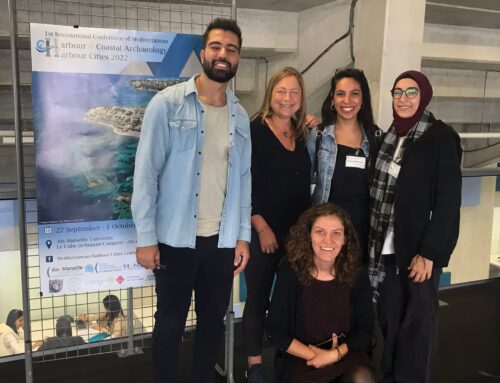Up from the Sea: mariner networks in ports across the Late Bronze Age east Mediterranean – 2016
L. Hulin and S. German
Activities
The Honor Frost Foundation provided funding for two activities: a scoping visit to Cyprus and fieldwork in Crete and Cyprus. We met Despo Pilides, Chief curator of museums in Cyprus, on 20th May and she was very supportive of the project and we discussed the location of the material in Larnaca museum and its main storerooms in Terra Umbra.
From 2nd-9th June we were based in Pitsidia, Crete, while reviewing material from Kommos. Excavation day books, summaries, small finds catalogues and the material itself are housed in a purpose built storeroom, with dedicated space for reviewing material. The helpfulness of Joseph and Maria Shaw, and their patience in dealing with questions on the minutiae of day to day excavations cannot be underestimated. We are grateful for their generosity.
From 14th-30th June we were in Larnaca, working in the storerooms at Terra Umbra, apart from one day in the storerooms of the museum looking at small finds housed in the secured rooms there. The material from Area 8, excavated by Paul Åström, is stored in three different buildings in the Terra Umbra site. Karin Nys, who is preparing Åström’s work for publication and who supervised the transfer of the material from his dig house in Dromolaxia to Terra Umbra, helped us track down more obscure objects in the second week of our work. We also engaged in useful dialogue with David Reese, who is publishing the floral remains from the excavations. David has a deep knowledge of material from specific contexts — particularly the exotic fish that interested us — and we were able to place them in the wider material context, to our mutual benefit. We are indebted to them both.
Academic results of the first season
The tendency of sailors to congregate (or be confined) in areas within reach of the shore suggests a focus on modest dwellings in non-elite areas near the sea, where sailors would eat, sleep, swap news, repair gear and engage in petty trade. Such establishments need not have been architecturally different from their neighbours, but would be identifiable by their contents: larger than usual proportions of cooking, serving, eating and small storage wares and cooking implements to support large scale food production, such as grinders; a variety of low-value table wares, present in small quantities only, from across the eastern Mediterranean, which would reflect the practice, suggested above of mariners travelling with their own cups and dishes; the presence of exotic food items, and objects from across the Mediterranean, gathered to be traded; small scale tools, such as fish hooks or crucibles, gathered for trade, or for making items to be traded, and a range of portable religious objects or evidence of worship. These items may be found at a variety of buildings in a port, but the defining feature is their occurrence in non-elite settings, in small quantities and in unusual variety.
The sites of Kommos on the south coast of Crete and Hala Sultan Tekke on the south-east coast of Cyprus were chosen because they were both wealthy maritime commercial centres capable of receiving large ships with large cargoes that would take time to load and unload.
At both sites, rooms and deposits of interest were identified by the variety of imported ceramics and small finds published, the latter indicating small-scale metalworking, cloth manufacture, and fishing. Context sherds from these deposits were sorted into diagnostic shapes and ware types. Within reconstructions of the contents of individual rooms, the variety of vessels was the prime concern and in this way differences in retention policy by different excavators and variances in site morphology were smoothed out: duplicates were removed until only one of each type and fabric remained. Sherds were grouped into six functional categories: (1) vessels for eating and drinking; (2) for serving (groups 1 and 2 being divided into painted, plain and coarse); (3) kitchen shapes (cooking pots and platters); (4) small storage (i.e., portable containers, from stirrup jars to Canaanite amphora); (5) large storage (pithoi); and (6) personal (perfume juglets and stirrups jars). The results of these analyses were added to published material, alongside small finds and faunal analyses. Even at this early stage, there is evidence that supports our model, but also suggests divergent practices at the two sites.
Kommos on Crete is situated at the end of the Messara plain and is thought to have been connected to the Minoan palace of Phaistos six kilometers to the northeast. Attention was focused on a group of rooms in two LMIIIA1 structures, Buildings N and P. Building N (Shaw and Shaw 1990: 60-64) consists of six rooms and a court on the western edge of the Southern Civic Area adjacent to Building P, the ship shed structure. It is decidedly non-elite, lacking ashlar masonry, exotic elite items or any magnitude of fine dining wares. Its non-elite status is especially stark when compared to contemporary Building X, which contained many elite ceramic wares as well as wall and floor painting.
In Building N, 2 large rooms and their associated walled courtyard were examined. In room 5, 168 vessels were identified, consisting of equal proportions of small storage wares and eating wares, closely followed by painted serving wares. Indications of food preparation were also present: a whetstone and hammer stone, pumice and animal bone. A further 46 pots were found in room 4, with eating and storage wares occurring in similar proportions. Outer room 7 contained 70 unique vessels, 76% of which were devoted to eating, with small storage and a few personal containers making up the rest. In courtyard room 6 there were lower levels of eating wares, (c. 35%), although they were still in the majority, alongside roughly equivalent proportions of serving and kitchen wares and small storage jars.
In sum, this group of rooms seem to have prepared and served food in significant quantities, larger than one would expect for purely domestic purposes. In the innermost room there were also fragments of three imported vessels: a Sardinian jar and dolio, and an Egyptian amphora. The outer room also contained a Sardinian bowl, and the courtyard contained a Sardinian jar, as well as a Cypriot milk bowl and two Canaanite jars. Sardinian vessels are relatively rare at Kommos, most are in the elite settlement area up the hill and present commodity storage vessels (Watrous 1992: 163-7). The vessels in Building N, particularly the cooking pot, suggests food preparation to Sardinian taste: either Sardinian sailors or locals catering for visitors from the central Mediterranean. Small scraps of bronze, associated with patches of burning suggests small-scale metal working, coparable to activities at Marsa Matruh.
Building P, the ship shed, offers a different picture of mariner activity. Work focused on bay 3 (P3) and the eastern extremity of bay 2 (P2) (Shaw and Shaw 1990: 76-82). At the eastern end of P3, 1/5th of the 186 vessls identified were small storage pots, closely followed by painted eating wares and, to a lesser extent by painted serving and kitchen wares. Included in the ceramic record here were two Canaanite jars and five Egyptian storage vessels (each one a different shape). The variety of Egyptian jars suggests an accumulation of Egyptian jars, rather than a coordinated consignment. This area also contained 54 bronze strips and rods and two bronze blades. The deposits at the middle of P3, contained equal proportions of small storage and eating wares, amounting to nearly half of the 171 vessels recorded, and lesser proportions of serving and eating wares. The presence of burning and animal bone suggests the preparation and consumption of meals. At the western end of P3, closest to the sea, 166 vessels were identified, a third of which were painted eating vessels, a similar proportion of small storage vessels, and serving vessels. A single New Kingdom amphora fragment was also found.
The eastern segment of P2 contained the remains of a large hearth. Over 70% of the 196 vessels found were storage vessels, including two New Kingdom amphora and a Canaanite jar; serving vessels were in the minority. Remains of a Cypriot base ring ware vessel were also found. There was much less evidence for metal-working or scrap collection or repair work in this area: only two nail fragments and one bronze strip were found.
Thus, two different types of mariner are observable at Kommos. In building N, there is a configuration of rooms differentiated by focused primarily on eating (N7 and courtyard 6) or cooking and working (N5 and N4). The ship sheds present something different. At the time they were occupied, they appear not to have contained ships (P3 was divided into small areas by rough low stone walls), and instead they seem to have been to a lesser extent for cooking and eating and more for working and repairs.
The LBA port of Hala Sultan Tekke was situated on the edge of a sheltered lagoon in Larnaca Bay and connected with routes to copper deposits inland. Area 8, at the northeastern edge of the site, lay close to the edge of the lagoon, and consists of a number of houses, arranged on a rough grid pattern. Each contained a number of small rooms around a central courtyard, with some, like Building A, having its own well. The houses, although more complex that the one studied at Kommos, were not in the elite area of Hala Sultan Tekke, which lay further to the southwest, and the quality of their construction is not high, comparatively. It was flagged up in the original publication as containing an unusually large number of open serving bowls, making it look very much more like a lodging than a private house (Hult 1981). All the excavated rooms and portions of the courtyard of Building A were examined. In comparison with the neighboring Building B, roughly double the quantities of eating and drinking vessels were found.
Room 2 appears to have been a multi-purpose, working and cooking space, not surprising given its well, with over 60% of the 281 vessels identified belonging to kitchen, serving and, to a lesser extent, eating shapes. Rooms 3 (113 pots identified) and 7 (147 pots), on the other hand, have very similar configurations of vessel types, which reflect similar proportions of small storage, eating and drinking, and serving vessels, as does courtyard 10 (1067 shapes). All rooms contained a range of imported Mycenaean storage and eating vessels, and Canaanite jars (some possibly locally made), but all in low quantities, as one might expect of non-elite areas. The exception to this is courtyard 10, where roughly 10% of the ceramic record are imports including Canaanite and Egyptian storage jars, Mycenaean eating and drinking vessels, stirrup jars, a squat alabastron, painted storage vessels and Mycenaean craters, including 2 chariot types, as well as a Levantine serving vessel and pilgrim flask.
Building B, which abuts Building A, was only partially studied, but appears to have a different profile. When comparing rooms of similar size and location in Buildings A and B, preliminary analysis suggests that Building A would contain double the amount of eating and drinking wares, and a wider range of painted wares and exotica.
Inlided in the latter category in Building A are an ivory disc and limestone vessel fragment and a faience sceptre head with the cartouche of Ramesses II in room 2, pieces of ostrich egg shell in room 4, and several beads of faience, stone, amber and ivory in courtyard 10. These are just the kinds of small, portable objects that we might expect to make up petty trade. Much has been made of the sceptre head; however, it should be remembered that faience was not a particularly expensive in Egypt and its presence need not confer elite status on Building A. Bronze implements (tweezers, weights, arrowheads) and slag were found in the courtyard and room 2, reminiscent of activities in Marsa Matruh and Zawiyet Umm el Rakham, and stone weights. Nile perch was also present in Building A, and exotic foodstuff difficult to explain in this non-elite area other than by the presence of mariners.
Conclusion
There emerges then a picture of spaces at Kommos and Hala Sultan Tekke where there was a lot of eating and drinking, amid the presence of a range of low-level imports. Building A and Building N offered comparable facilities, albeit at different scales. Multi-purpose spaces, (with evidence of food storage, cooking, serving and eating, as well as working) were found in courtyards and indoors, whereas areas dedicated to eating and drinking were always indoors, perhaps offering year-round, all-weather facilities for mariners. The ship sheds at Kommos offer a different picture. P3 offered space for work, storage and eating, whereas P2 shows little evidence of commensality, perhaps because the hearth would have made the enclosed space too smoky for comfort.
It may also be possible, even at this early stage, to identify different patterns of interaction in these non-elite, mariner areas. Kommos shows contacts with Sardinia, and quantitatively fewer with the Levant and Egypt; Hala Sultan Tekke which, while lacking evidence of contact with the central Mediterranean, offers evidence of much more robust contact with the Levant and Egypt, as well as the Mycenaean world of which Crete was by then a part. There is also a marked lack of small exotica at Kommos, compared to Halan Sultan Tekke. Was this because even small items at Kommos were immediately taken by the elite areas or sent further inland, or might this be an indication of different mariner networks in operation?
The pilot study and proof of model begun at Kommos and Hala Sultan Tekke has immediately illustrated the complexity of mariners lives on shore and, at the same time, generates more questions for the future.
Hult, G. (1981) Hala Sultan Tekke 7: Excavations in Area 8 in 1977. Studies in Mediterranean Archaeology Vol. XLV:7. Goteborg.
Shaw, J. and Shaw, M. (1990) Kommos: an Excavation on the South Coast of Crete, volume V. Princeton.
Watrous, L. (1992) Kommos: An Excavation on the South Coast of Crete, Volume III: The Late Bronze Age Pottery. Princeton: 163-67.
Outreach and output
The overall model for the project was presented at the American Institute of Archaeology (AIA) annual meeting in January 2016, in the Oxford Centre for Maritime Archaeology seminar series in March, and at the International Congress of the Archaeology of the Ancient Near East (ICAANE 10) in May. The model, with preliminary results based upon the first season of field work was presented at the American Schools of Archaeological Research Annual meeting in November 2016 and will also be published in the proceedings of ICAANE 10:
L. Hulin and S. German (in press) ‘Up from the Sea: Mariner Networks in Ports across the Late Bronze Age Eastern Mediterranean’, in Proceedings of the International Congress on the Archaeology of the Ancient Near East (Band 10). Harrassowitz Verlag.
The presentation at ASOR proved to be very useful for the project: L. Hulin received an invitation to review the ceramics from the most recent excavation of the Cape Gelidonya shipwreck from Nicolle Hirschfield.




